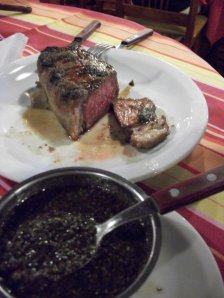Argentinean Beef & Chimichurri
“Eating industrialized meat takes an almost heroic act of not knowing or, now, forgetting.”
-Michael Pollan, author, “The Omnivore’s Dilemma“
After finishing our last Saturday cleaning of the DOM kitchen and saying our farewells to the staff and interns, Alex and I raced home to pack our bags and then headed to the airport. My 90 day visa for Brazil was 6 days from expiring, and I didn’t want to get slapped with the R$8 fine per day if I overstayed – especially since we have extensive travel plans within Brazil during the next few weeks. We figured that the easiest way to get a new visa would be to…you know, leave the country. We picked Foz do Iguaçu, the border town between Brazil, Argentina, and Paraguay (mainly because there’s an airport on the Brazilian side, meaning it’s a super cheap domestic flight :p). It’s also a UNESCO World Heritage Site and one of the finalists for the New 7 Wonders of Nature – so we figured it wouldn’t be a bad weekend trip. Alex also has a friend from high school who lives there, so as an added plus, we had great company and a place to stay.
If you ever get the chance to visit Iguaçu (pronounced ig-wah-SUE), do it. If you’ve ever been to Niagara Falls (Toronto/Buffalo area), multiply the size, amount of waterfalls, and sheer splendor of that by at least 15 – that should give a vague starting point of how incredibly massive Iguaçu is. On the Argentinean side, there’s an almost mile-long catwalk built over the river that takes you to the very top of the mouth of the falls – they call it “the devil’s throat.” There are tons of hiking trails, dozens of boat tours, cute furry animals called coati… and the exchange rate is pretty good (about 4 pesos for every dollar).
A word of advice: If you ever find yourself wanting to stay in Brazil for longer than 90 days, know that simply crossing the border for two afternoons doesn’t fly with the Immigration officials. We went in and out of Paraguay once and Argentina at least 3 times – only to be sent to the Federal Police in Brazil where I had to fill out a ton of paperwork, wait in long lines, leave to make copies of my documents, wait some more, and finally pay the R$68 visa extension fee – just to get the stamp in my passport saying I can stay until May. We learned after the fact that all of this could have been accomplished just as easily without leaving São Paulo…. but we had a great time and several great meals that definitely made the trip worth it!
After a long day of hiking, drinking mate, and sightseeing, our hosts Augusto and Luciana suggested we have dinner at a small, authentic barbecue restaurant in the province of Misiones, Argentina called El Quincho del Tio Querido. I had heard about the superb quality of Argentinean beef several times before, and was excited to try it at the source. We all ordered filet, which came with the traditional “green sauce” known as Chimichurri. To be honest, it was one of the best steaks I have ever had. It may not have been the absolute most tender piece of meat in the world, but it was nowhere near tough – and the flavor was incredible. It tasted… like a cow should taste. Plain and simple.
Chimichurri
Chimichurri is the traditional accompaniment to Argentinean grilled meats. It can be found everywhere, from the most humble neighborhood restaurants to the fanciest steakhouses. No two chimichurri recipes are exactly alike, but all versions start out with the same ingredients in the base: fresh parsley, fresh oregano, garlic, olive oil, wine vinegar, and chili. It’s essentially a type of vinaigrette, and can be either blended finely in a food processor to create a smooth sauce or roughly chopped by hand for more of a salsa texture. It can be used as a marinade, a basting sauce during cooking, a dressing for accompanying greens, or as a dipping sauce.
Several stories of the origin of the name “chimichurri” exist. All of the stories involve an English speaking colonist and the corruption of names or words by the local population. One story involves Jimmy Curry, an English meat importer; another a Scottish traveler called James C. Hurray; there’s also Jimmy McCurry, the Irishman who is said to have first prepared the sauce (the locals supposedly changed the name of the sauce in his honor). One Argentinean claims that the word chimichurri originated after England tried to invade the Spanish colony of Argentina. The British prisoners asked for the sauce for their food, mixing English, aboriginal and Spanish words. Che-mi-curry stands for “che mi salsa” (dame condimento) or “give me curry.” Later “che-mi-curry” corrupted to chimichurri.
To make chimichurri, you’ll need:
- 1 bunch of parsley, washed and chopped
- 1 T oregano
- 1 head garlic, peeled and minced (or about 6-7 T)
- 1 medium onion, minced
- 2 bay leaves, chopped very fine
- 1/2 c. olive oil
- 1/4 c. wine vinegar (red, white, or rice)
- 1/4 c. water
- salt, pepper, and chili (flakes, paste, sauce, whatever) to taste
-Chop everything. Put a little bit of the oil in a small saucepan and add the garlic and onions. Sweat over low heat until soft but not brown.
-If you prefer smoother sauces, pulse everything in a food processor. If you like it chunkier, toss everything together by hand.
-Add the liquids, season it, and serve!
Note: Sweating the onion and garlic helps to tame the pungency of the sauce. If you prefer, you can also marinate everything raw overnight – just don’t add the oil until you’re ready to serve it. If you’re making a chunkier sauce, the liquid should more than cover the other ingredients – stretch it out with more oil and vinegar if you need to.
If you’d like, check out Steven Raichlan’s Chimichurri recipe for a slight variation. He’s practically the modern father of grilling and barbecue… and he also happens to be one of our former bosses (Greenbrier Resort, WV). 🙂
*
*
The Argentinean Beef Industry (a brief introduction)
In Argentina, beef has been the primary meat in the national diet for nearly a century. It is estimated today that Argentina is one of the largest consumers of beef in the world, second only to the United States. However, Argentina only has a population of 33 million people, while the United States has 230 Million people – meaning that the amount of beef per person for Argentina is much larger than that of the United States. The average Argentinean consumer eats 190 pounds per year, which is approximately 2 ½ times more than the average American, who consumes 78 pounds per year.
In the U.S., the market for Argentine beef for human consumption (steak) is very limited because domestic cuts of meat are much cheaper to produce. Additionally, and perhaps more importantly, American consumers are not accustomed to the taste of South American beef, which is grass-fed and less tender than the grain-fed beef of the United States. The United States has been a constant consumer of Argentine beef products, but mostly in the canned soup and pet food markets. This was the saddest statistic I have read so far – to think that all of this wonderful, delicious, healthy grass-fed beef is wasted in pet food and over-processed “soup”.
Argentina’s rainfall and largely temperate climate result in high quality pastures, and the humid Pampas (central-northern Argentina) is the most important and best-known cattle-producing region because it has vast and open pastures. Grass-fed beef is healthier than beef from feedlots – it contains less saturated fat and more omega 3 fatty acids than grain-fed beef – meaning that it’s less likely to raise cholesterol in humans. Grass-fed cattle are living under more natural conditions, and are also less likely to have hormone implants. In The Omnivore’s Dilemma, Michael Pollan explains that grass-fed cows have an ideal ratio between omega-3 and omega-6:
“Omega-6 is produced in the seeds of plants; omega-3 in the leaves. Both kinds of fat are essential, but problems arise when they fall out of balance. (In fact, there’s research to suggest that the ratio of these fats in our diets may be more important than the amounts) Too high a ratio of omega-6 to omega-3 can contribute to heart disease, probably because omega-6 helps blood clot, while omega-3 helps it flow. (Omega-6 is an inflammatory; omega-3 is an anti-inflammatory) As our diet – and the diet of the animals we eat – shifted from one based on green plants to one based on grain (from grass to corn), the ratio of omega-6 to omega-3 has gone from roughly one to one (6:3) to more than ten to one (6:3). […] Changes in the composition of fats in our diet may account for many of the diseases of civilization – cardiac, diabetes, obesity, etc. – that have long been linked to modern eating habits.”
Food for thought, no? I highly suggest picking up The Omnivore’s Dilemma if you haven’t read it – it’s one of those books that you never knew you needed to read until you’ve finished reading it.
One last thing that I found interesting – In 1905, the government of Chile kept the price of beef from Argentina artificially high by applying a special tariff to cattle imports from Argentina in order to protect the domestic producers. That (along with a runaway inflation) led to the Meat Riots of 1905, one of the first major riots in Santiago. The riots lasted from October 22 until October 27; between 200 -250 people were killed, while more than 500 were injured. If people are willing to die for it, it must be good! =)







Heather! this is so awesome! I have definetly enjoyed reading your random posts on facebook but this is so fucking amazing. SO JEALOUS!!!
I’m glad you liked it! We had a great time there and it’s definitely a country I’d love to spend more time in.
I actually stopped eating meat for several months before we left the US because it’s just… not good. Now, I feel like it’ll be almost impossible to justify why eating a corn-fattened piece of American meat could ever seem like a good idea.
I hope you get the opportunity to travel, too – if we cross paths again, you have a place to stay 🙂
Heather/Alex,
Great information and fun to read!
I am looking forward to your next post.
Ken (Florida)
Dad! I’m glad you enjoy this – Thanks for all your support!